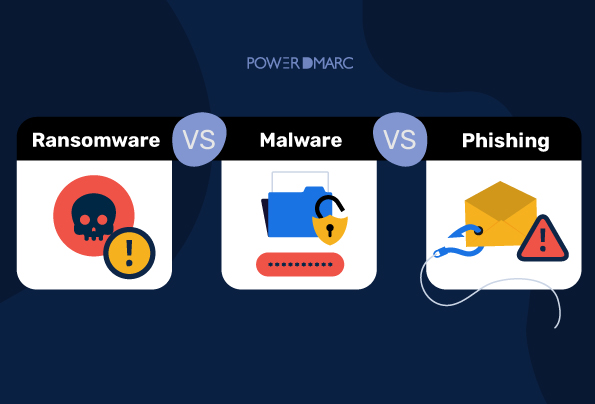Ransomware, malware, and phishing are three types of online threats that have been around for years. All three can be deployed via email, are detrimental to an organization, and can lead to the loss of financial or informational assets. They can be difficult to tell apart, but our ransomware vs malware vs phishing guide is here to highlight some key differences between them.
Here’s a breakdown:
Ransomware Vs Malware Vs Phishing: Definitions
Ransomware Vs Malware
Ransomware is a type of malware that can encrypt your files and then make them inaccessible unless you pay the cybercriminals who sent it a ransom. The problem is that this isn’t just any old malware—it’s specifically designed to make you pay money by taking control of your computer and holding your files hostage until you pay up. Ransomware may also operate as a service commonly known as RaaS.
Malware is another type of threat that can infect your computer and make it unusable. In most cases, malware doesn’t demand payment in exchange for removing itself from your device—instead, it will leave behind unwanted programs or files on your hard drive or laptop after it takes over your system.
Ransomware and Malware Vs Phishing
Phishing attacks involve sending emails with links or attachments that appear to come from trusted websites like Facebook or Gmail but lead to malicious sites controlled by cybercriminals who want to steal information about you or other people on the internet so they can commit identity fraud later down the road (like when trying to buy plane tickets).
Differences in Attack Prevention and Mitigation
Ransomware attack prevention
Ransomware can be spread through email, social media, and other online services, or it can be downloaded from a website. It’s often used to extort money from victims, in what’s known as a “ransomware attack.”
The best way to prevent ransomware attacks is to use strong passwords and other security measures that protect your system and emails such as reliable anti-virus software and email authentication protocols like DMARC, respectively.
Read our full guide on DMARC and ransomware.
Ransomware attack mitigation
If you’ve been affected by a ransomware attack, there are some things you can do right away:
- Make sure all the files on your PC are backed up and saved somewhere else (like an external hard drive)
- Remove any suspicious software from your computer and don’t install new software until the infection has been removed completely (or at least until there’s no risk)
- Don’t open any emails asking for money—don’t click on links in them either!
- If possible, connect with friends or family members who have access to their computers so they can help clean up after you’re done
- Consider having someone take over your account if possible so that only one person has access to it at once; this will make it easier for them to clean
Malware attack prevention
- The first step is to install antivirus software on your computer. Antivirus software can detect and remove viruses and other types of malicious software from your computer. This should be done as soon as possible after you have been infected with malware so that it can be removed before any damage has been done to your computer.
- Another way of preventing malware attacks is by keeping your operating system up to date. Most operating systems come with automatic updates that help keep them secure against new viruses and other types of malware by automatically downloading them when they become available online or through an update application on your computer. If there are no updates available for an operating system then it is best not to install anything until an update has been released for that particular version of the OS (Operating System).
- A third way of preventing malware attacks is by using strong passwords whenever possible instead of using simple ones like 12345.
Malware attack mitigation
If your computer is infected with malware, don’t wait! Run a full scan with an antivirus program before attempting any other steps.
When a computer is infected with malware, it can spread quickly and cause more problems than just slowing down your computer. So make sure that you run a full scan before trying any other methods of recovering from a malware attack.
Phishing attack prevention
DMARC is one of the most effective ways to combat this type of attack because it can help prevent attackers from getting hold of your domain name, which would allow them to impersonate your site or service, and thus get access to your customer’s data. However, you need to be on an enforced DMARC policy of p=reject to prevent the attacks.
Phishing attack mitigation
If your customers are receiving phishing emails that seem to be originating from your domain, you need a mechanism in place to track down these malicious IPs. DMARC reports are an excellent way to monitor your sending sources and track these IPs to blacklist them faster.
We recommend configuring our DMARC report analyzer to view your reports in a human-readable (non-XML) format.
Conclusion
In short, Ransomware is a type of malware that encrypts files on your computer, holding them hostage until you pay up to have them unlocked. Malware is any kind of software that alters or deletes data without your explicit consent. Phishing is when scammers pretend to be someone you know—like your bank or employer—and ask you to provide sensitive information like usernames and passwords.
However, all three can be administered to a user via fake emails from a spoofed address pretending to be you! Protect your domain’s emails today with a DMARC analyzer and never worry about impersonation threats again!
- Can Blockchain Help Improve Email Security? - May 9, 2024
- Datacenter Proxies: Unveiling the Workhorse of the Proxy World - May 7, 2024
- Kimsuky Exploits DMARC “None” Policies in Recent Phishing Attacks - May 6, 2024
